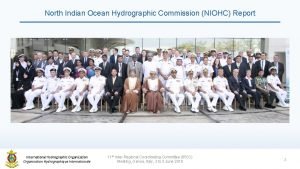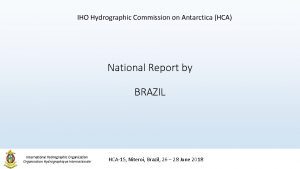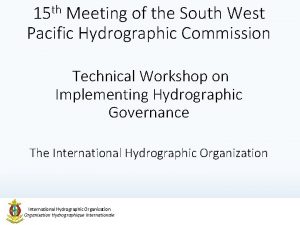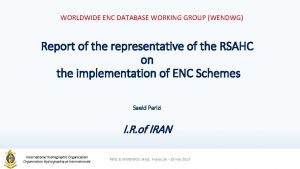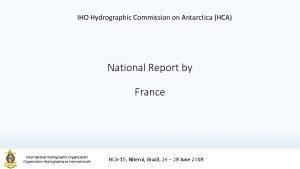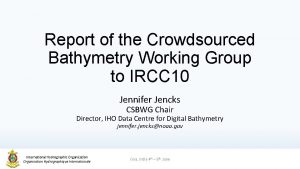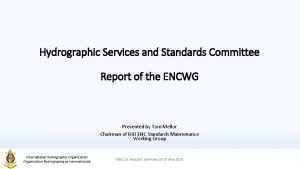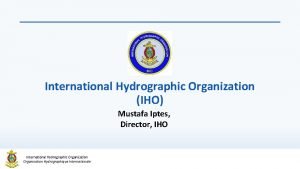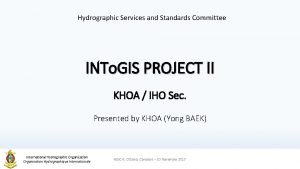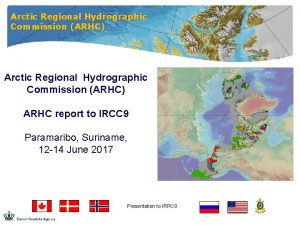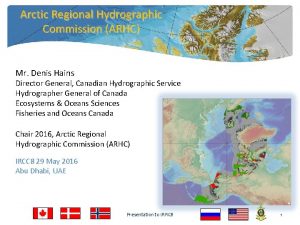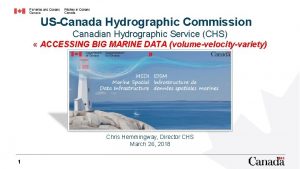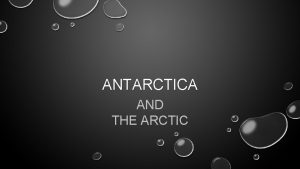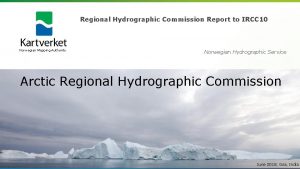Arctic Regional Hydrographic Commission ARHC Report to the








- Slides: 8

Arctic Regional Hydrographic Commission (ARHC) Report to the IRCC-7 ARHC Chair Captain Sergey Travin Department of Navigation and Oceanography, Russian Federation Mexico City, Mexico June 2015 Presentation to IRCC 7 2015 1

Arctic Regional Hydrographic Commission • Highlights since IRCC-6 (2014) – Responded to request of PAME (Arctic Council) to assess chart adequacy in the Arctic and report at PAME-II 2014 – Progressed the concept of an Arctic Voyage Planning Guide for anticipated launching in 2015 after ARHC-5 discussion – Conducted special inter-sessional meeting of ARHC-5 in October during the EIHC – Finland, Iceland the IHB continue as ARHC Associate Members Presentation to IRCC 7, 2015 2

Arctic Regional Hydrographic Commission • Responding to PAME Presentation to IRCC 7, 2015 3

Arctic Regional Hydrographic Commission ARHC’s Methodology to Answering PAME (Ref. : IRCC 7 -11 G A Risk-based Methodology of Assessing the Adequacy of Charting Products in the Arctic Region: Identifying the Survey Priorities of the Future) 1. 2. Assess confidence of the present hydrographic holdings (Age of data, Type of coverage, etc. ). Divide ocean into general depth categories based (shallow, mid-depth, deep) factoring in seafloor complexity. Ex: across a broad flat shelf, 30 m could be considered “deep”; whereas, in areas with the potential for sharp, sudden rises in the seafloor, 50 m could be considered “shallow”) 3. Intersect confidence (#1) with depth bands (#2) to develop potential areas of concern. Ex: Higher conf. hydro plus deeper depths = Lower concern Ex: Lower conf. hydro plus shallower depths = Higher concern 4. 5. Assess historic traffic patterns as they relate to the areas of concern (#3). Generate maps and statistics which can guide decision-making processes. Ex: Hydrographic organizations can determine survey priorities Ex: Coast Guards can determine where to stage equipment for potential rescue or spill response events. Presentation to IRCC 7, 2015 4

Assessing Arctic Survey Adequacy Methodology Flow Chart 1. Determine Confidence of Hydrographic Holdings. Measuring Equipment Used Age of Data High Confidence Shallow Med. Confidence Mid-depth Surveying Technique Low Confidence Deep Other Simple: 0 -20 m, 20 -50 m, > 50 m 50+ m Complex: 0 -100 m, Complex: 0 -100 m 100 -200 m, 100 -200 m 200+ m > 200 m Depth + Seafloor Complexity Unassessed 3. Intersect Areas of Confidence with Depth Areas to determine Potential Areas of Concern. (e. g. Higher Confidence and/or Deeper Depths) 2. Define Depth Bands based on Seafloor Complexity. Lowest Concern Low Concern Med. Concern 4. Extract “High Risk” Vessel Traffic Tracklines and Intersect with Potential Areas of Concern. Satellite-Observed Vessel Traffic Patterns Higher Risk Vessels: • Tankers • Cargo and Tugs • Passenger Vessels Output: • Frequency of Vessels transiting within Areas of Higher/Lower Concern… • … thus quantifying whether region is adequately charted. High Concern (e. g. Lower Confidence and/or Shallower Depths) Highest Concern 5. Compute Area Geometry of Potential Areas of Concern and Linear Distance Traversed by 5 Vessel Traffic within each Area type.

Arctic Regional Hydrographic Commission • Key messages to PAME Arctic Council – Hydrography matters • Critical for the protection of the Arctic marine environment through safe navigation and better science which underpins: – Safe maritime commerce – Resilient coastal communities – Ecosystem management (e. g. sensitive areas) – ARHC is the expert group actively conducting hydrographyrelated science and analysis in the Arctic • Independent, inter-governmental, and inclusive • Committed to long-term partnerships • This work is just beginning Presentation to IRCC 7, 2015 6

Arctic Regional Hydrographic Commission Next Steps – August: WMU/WMO Ship. Arc 2015 Conference (Malmö, Sweden) – Denmark Geodata Agency will present on behalf of ARHC – September: PAME-II in September 2015 (Tromso, Norway) • PAME requests the Secretariat to invite the Arctic Regional Hydrographic Commission (ARHC) to submit and update progress on the status of Arctic hydrography and charting, as well as any developments with respect to Arctic Voyage Planning Guides. • The Chair of OTWG is currently seeking additional MS contributions to the Hydrography and charting assessment and methodology – Ongoing: Complete ARHC-4 actions and consider more collaborative regional effort to respond on such topics as C-55 and ARHC input to the IHO work program, etc… – Pending: ARHC-5 (Tentative November 2015) – ARHC-5: AVPG review and hoped for release with help of IHO portal Presentation to IRCC 7, 2015 7

Arctic Regional Hydrographic Commission Contacts: Russian Federation: (ARHC Chair) Captain Sergey Travin, Dept. of Navigation and Oceanography, unio_main@mil. ru Canada: (ARHC Vice-Chair) Mr. Denis Hains, Canadian Hydrographic Service & Oceanographic Services , denis. hains@dfo-mpo. gc. ca Denmark: Ms. Anne-Sofie, Danish Geodata Agency Norway: Mr. Evert Flier, Norwegian Hydrographic Service, Evert. Flier@kartverket. no United States of America: (NOAA and Department of Defense), RDML Gerd F. Glang, gerd. glang@noaa. gov John E. Lowell, john. e. lowell@nga. mil and RDML Tim Gallaudet, timothy. gallaudet@navy. mil Presentation to IRCC 7, 2015 8
